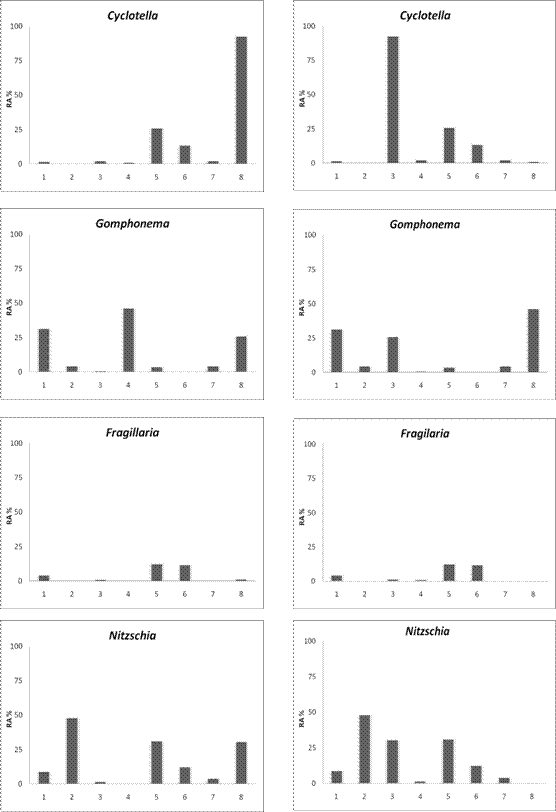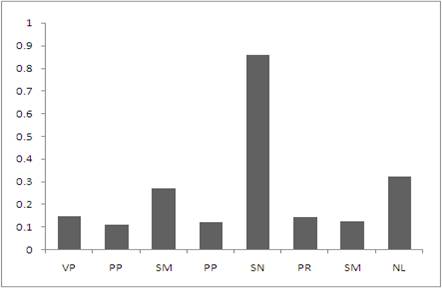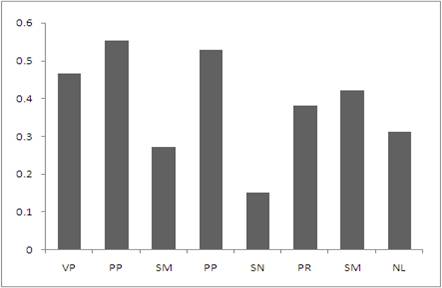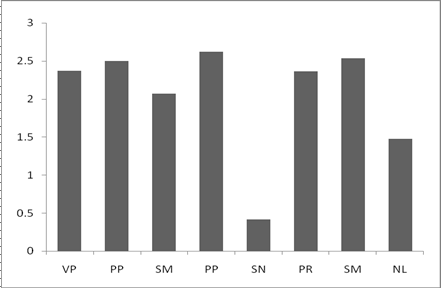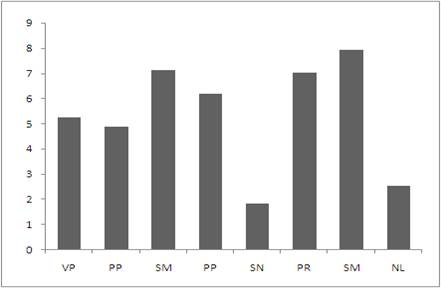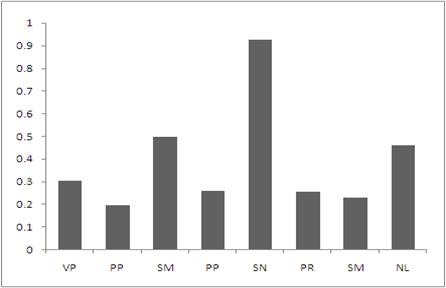 |
Pollution Monitoring in Urban Wetlands of Coimbatore, Tamil Nadu
|
 |
Centre for Ecological Sciences, Indian Institute of Science, Bangalore
Web: http://ces.iisc.ac.in/energy/, http://ces.iisc.ac.in/biodiversity Email: cestvr@ces.iisc.ac.in, energy@ces.iisc.ac.in
|
Results and Discussion Water samples were collected from all sites and physical variables like pH, Temperature, Electric conductivity, Salinity and Total dissolved solids were measured and are listed in Table 3. pH of sampled wetlands range from 7.4 to 9 indicating neutral to alkaline conditions. Electric conductivity ranges from 280 (Vedapatti) - 2250µS/cm (Singanallur). Table 3 : Water Quality Variables of Coimbatore Wetlands
Diatom Diversity Diatom samples were collected (from cobbles, aquatic plants and sediment) and prepared using standard methods from Vedapatti, Pallapalayam, Sundakamuthur, Perur, Noyyal and Singanallur wetlands in Coimbatore. Diatom communities were analysed as explained in methods section. 96 Species belonging to 34 Genera were recorded from these wetlands, which are provided in Appendix 1. Among these species, 27 species were dominant (i.e., occurring >5% of any given community). Appendix 2 gives the species-wise light microscopic illustrations. Table 3 lists the diversity indices, which show a significant difference in community structures across the sampled wetlands. Higher values of Shannon, Simpson and evenness values are for Pallapalayam wetland compared to Singanallur wetland, where dominance index was relatively higher. Table 4 : Diversity indices for Coimbatore wetlands
Note: VP- Vedapatti (Epiphytic); PP- Pallapalayam (Epilithic); SM- Sundakamuthur (Episammic); PP-Pallapalayam (Epiphytic); SN-Singanallur (Epiphytic); PR-Perur (Epiphytic); SM- Sundakamuthur (Epiphytic); NL-Noyyal (Epiphytic) Common diatoms genera namely Cyclotella, Gomphonema, Nitzschia and Fragilaria accounted for large proportion of the community in all sites. Figure 2, a plot of genera across pH and electrical conductivity ranges reveal that:
Dominance is the degree to which different species in an ecological community predominate, ranging from 0 (all taxa are equally present) to 1 (a taxon dominates the community completely). Dominance is calculated (equation 4, Table 1) and is given in Figure 3. Singanallur wetland has 10 species with Cyclotella meneghiniana as dominant species (dominance: 0.85), while Aulocosira granulata (19.86 %,) dominated Pallapalayam (dominance: 0.11) and Sellaphora pupula (23.17%) and Gomphonema parvulum (18.48%) were prominent species in Sundakamuthur (dominance: 0.12) wetlands. Remaining sites showed dominance index value between 0.1- 0.4.
Note: VP- Vedapatti wetland; PP- Pallapalayam wetland; SM- Sundakamuthur wetland; PP-Pallapalayam wetland; SN-Singanallur wetland; PR-Perur wetland ; SM- Sundakamuthur wetland; NL-Noyyal River EvennessEvenness is a measure of biodiversity which quantifies how equal the community is numerically. Figure 4 depicts the evenness computed as per equation 5, Table 1. Cyclotella meneghiniana constitute more than 90% of the total population accounted for low evenness in Singanallur wetland. In Pallapalayam wetland 22 species were recorded, among Aulocosira granulata and Nitzschia obtuse were represented by 19.86% and 14.61% abundance respectively.
Shannon diversity index (H’) computed as per equation 2 (Table 1) takes into account the number of individuals as well as number of taxa. This varies from 0 for communities with only a single taxon to high values for communities with many taxa, each with few individuals. Low H’ was recorded in Singanallur wetland (0.4135, C. meneghiniana representing 92%) and Noyyal River (1.472, Nitzschia sp representing 45.95 %). Species abundance in other sites ranges from 20 to 26 species that represent 15-50% of the total population.
Fisher alpha diversity Index High Fisher's alpha diversity index computed (equation 6, Table 1) was noticed in Sundakamuthur (7.8), Pallapalayam (6.2) and Perur (7) wetlands. Singanallur wetland and Noyyal River with less number of taxa shows low index value.
Berger-Parker is calculated (equation 7, Table 1) from the number of individuals in the dominant taxon relative to the total number of species. Cyclotella meneghiniana is the dominant species (with 92.68% abundance) showing a high index value in Singanallur wetland. Diadesmis confervaceae and Gomphonema turris was observed as abundant species (15-30%) in Vedapatti wetland. In Pallapalayam wetland Aulocosira granulata, Cyclotella meneghiniana and Nitzschia obtuse represents to 13-20% of the population from an epilithic habitat and Aulocosira granulata, Cyclotella meneghiniana represents 19-26% of the population from an epiphytic habitat. Gomphonema parvulum and Cymbella turgid represents25.47 and 22.25% respectively in Perur wetland. Nitzschia sp. (45%) and Navicula sp. (32%) characterize the Noyyal River. In Sundakamuthur wetland, Sellaphora pupula 49.63 % and Navicula rostellata 12.04% in episammic habitat whereas 23.17% Sellaphora pupula and 18.48% G. parvulum being present in epiphytic habitat (Figure 6).
Distribution of diatoms reflects the average ecological conditions of water (Cholnoky 1968; Lowe 1974). In Vedapatti wetland, cosmopolitan extreme pollution resistant species Diadesmis confervaceae, Gomphonema gracile and G.turris were dominant among 23 species highlighting eutrophic status of water with higher electrolyte. Aulocosira granulata and Cyclotella meneghiniana are dominant among 22 species in the epilithic substrata and 26 species in epiphytic substrata of Pallapalayam wetland. These species are cosmopolitan in distribution in both benthic and plankton representing electrolyte rich and brackish inland water. Episammic sample from Sundakamuthur is dominated by Sellaphora pupula and Navicula rostellata, which are more tolerant to high levels of pollution. Epiphytic substratum sample is represented by Gomphonema parvulum and G. affine, which are tolerant to extreme pollution and occurs in water with elevated electrolyte. Cyclotella meneghiniana a cosmopolitan species, resistant to extreme pollution with wide range of distribution including eutrophic, electrolyte rich water, accounts for more than 90% of 10 species in Singanallur wetland. Perur wetland with 28 species has Cymbella turgida, Gomphonema parvulum, Nitzschia clausii and N. obtuse as dominant species. Gomphonema parvulum and Nitzschia sp. survive even extreme pollution in wetlands where as Cymbella turgidathrive in mesotrophic to eutrophic condition. The assemblages of Noyyal river is similar as of Perur wetland, where this site is represented by Aulocosira granulata, Craticula ambigua, Gomphonema parvulum and Nitzschia sp. more in number. Aulocosira granulata and Craticula ambigua thrive in mesotrophic to eutrophic conditions and Gomphonema and Nitzschia sp. are capable of surviving even in extreme conditions of Pollution. A wide range of diatoms distribution is observed in all sampled wetlands of Coimbatore, which include Gomphonema sp. and Nitzschia sp. Aulocosira granulata, Cyclotella meneghiniana and Sellaphora pupula were dominant in Noyyal River, Pallapalayam and Sundakamuthur wetlands. These wetlands receives untreated sewage and are either eutrophic to mesotrophic evident from diatom assemblages. Diatom IndicesVariants of diatom indices have been used across the globe. Table 2 lists most commonly used diatom indices for representing the degree of pollution suitable for tropical conditions. Diatom indices listed in Table 3 were computed for all sampled wetlands to evaluate water quality. This diatom index score is expressed as water quality optima (i.e. the tolerate limits of diatoms to water quality variables) of the sample, based on the diatom taxa ‘i’ weighted by the abundance of each taxon. Table 5 : Diatom Indices values for the wetlands
Note: VP- Vedapatti wetland; PP- Pallapalayam wetland; SM- Sundakamuthur wetland; PP-Pallapalayam wetland; SN-Singanallur wetland; PP-Perur wetland ; SM- Sundakamuthur wetland; NL-Noyyal River. Refer Table 2 for details about the diatom indices IPS and GDI Indices attributing to trophic status are listed in Table 6 (adopted from Eloranta & Soininen, 2002, Taylor, 2004). Based on this, scores listed in Table 5, indicate an increasing level of pollution or eutrophication. Table 6 : Class limit values for Diatom indices (Eloranta & Soininen, 2002)
Diatom assemblages along with water quality class and trophic conditions of the wetlands are listed in Table 7. Table 7 : Trophic condition of the wetlands with dominant species
Habitat preference Diatom community structure varied very distinctly across the habitats. Epiphytic, Epilithic and Episammic habitats contained 50%, 10.4%, and 7.2% of taxa unique to that habitat. In all these habitats, Gomphonema affine, G.parvulum, Aulocosira granulata and Navicula roetellata were common, while G. parvulum and A. granulata were abundant. Table 8 lists species with their habitats, shows that majority of the diatom species are epiphytes. Diatoms specific to epilithic habitats are Fragilaria ungeriana, Thalassiosira duostra, Navicula anthracis, Eolimna subminuscula, Amphora veneta, Navicula veneta and Nitzschia sigma. Epilithic habitat supports both centric and pennate diatoms. Episammic habitat supported 10 species which includes Navicula viridula, Aulacoseira muzzanensis, Gomphonema pseudoaugar, Hantzschia sp., Anomoeoneis sphaerophora, Pinnularia microstauron, P.graciloides, P.interrupta, Caloneis bacillum and Rhopalodia sp. Cyclotella meneghiniana and Nitzschia obtuse were most abundant and specific to epiphytic and epilithic substrata. Similarly, species with average dominance were restricted to only epiphytic and episammic habitats. However, diatom community specific to both epilithic and episammic were absent. Table 8 : Species list with their occurrence in three habitats
|
||||||||||||
Citation: Karthick B, Alakananda B, and Ramachandra T V, 2009. Diatom Based Pollution Monitoring in Urban Wetlands of Coimbatore, Tamil Nadu. ENVironmentl Information System (ENVIS) Technical Report No. 31. Centre for Ecological Science, Indian Institute of Science, Bangalore |
|||||||||||||
| E-mail | Sahyadri | ENVIS | GRASS | Energy | CES | CST | CiSTUP | IISc | E-mail | |||||||||||||












